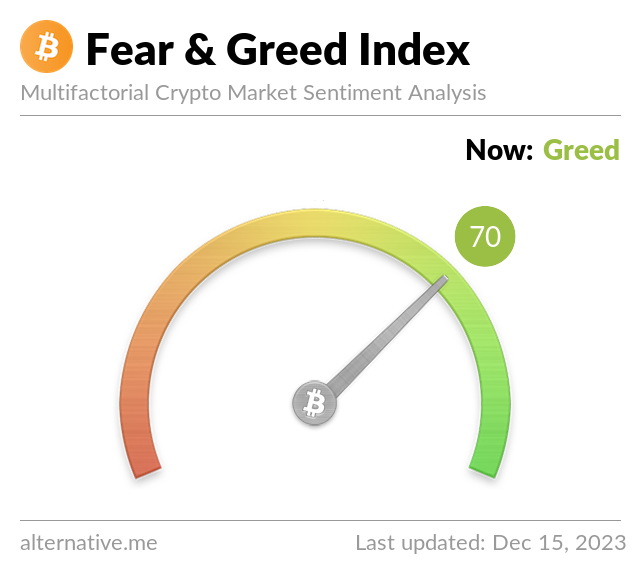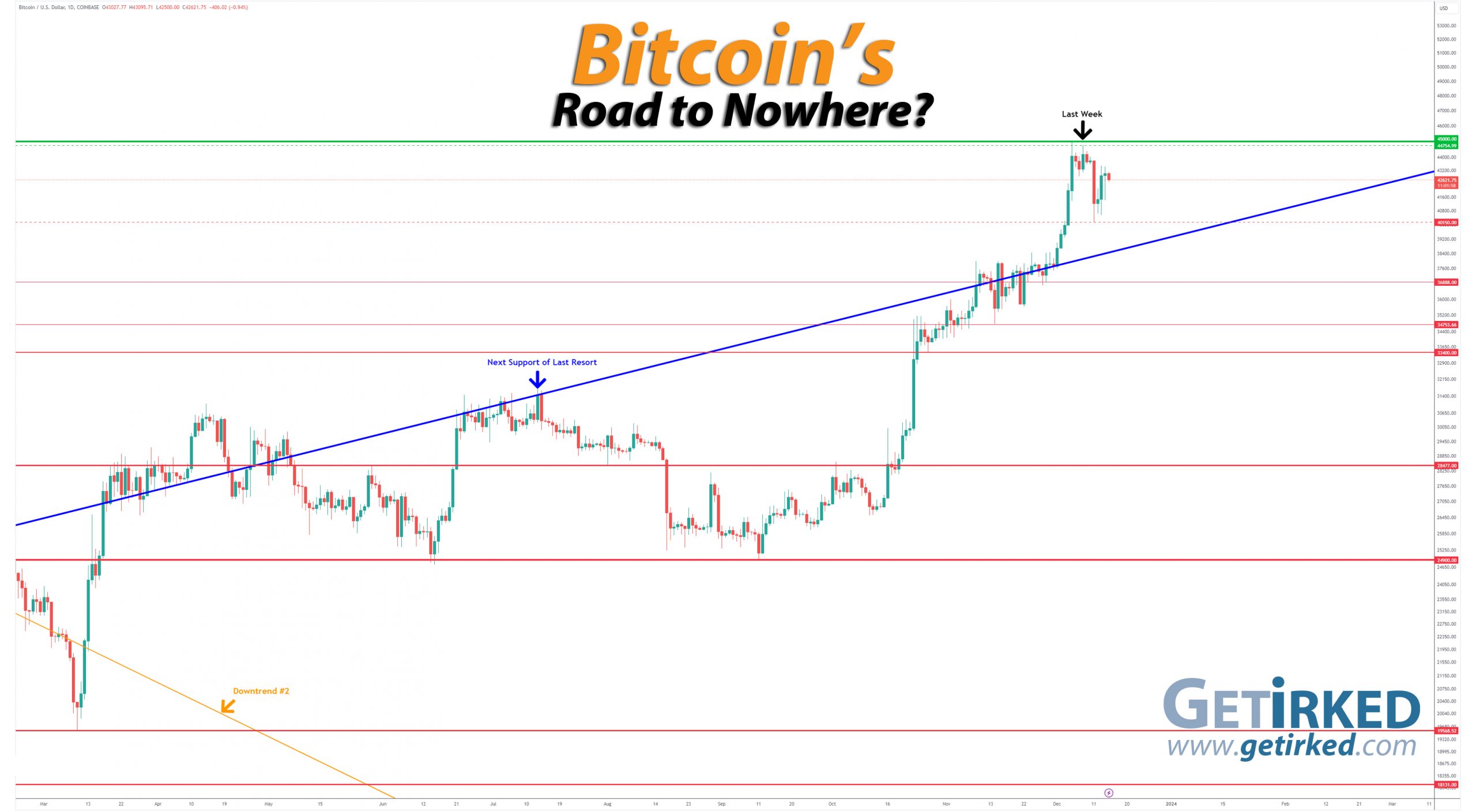Summing Up The Week
This week demonstrated the importance of staying in the markets. Many research studies show that if an investor misses just a handful of days over years, they can miss out on the majority of what their investments could earn during that time period.
This research was proven after the Federal Reserve Bank signaled the end of the interest rate hike cycle and even pointed to three rate cuts in 2024. Every single asset class took this news and ran with it, skyrocketing after Chairman Jerome Powell’s press conference on Wednesday.
Let’s take a look at the news that moved the markets this week…
Market News
CPI rose 0.1% in November but in-line year-over-year
On Tuesday, the Consumer Price Index (CPI) showed an increase in consumer prices in November of 0.1% – up 3.1% from a year ago – versus expectations for no gain and a yearly rate of 3.1%, reported CNBC. While the raise was a surprise, the in-line year-over-year result left the markets optimistic.
However, some pundits felt a little befuddled. The report was “somewhat in line, although, I suppose not as good as what some might have hoped that we would start to see more deceleration on a month over month basis,” said Liz Ann Sonders, chief investment strategist at Charles Schwab. The Fed “will probably talk about continued disinflation being good news.”
Disinflation is not the same as deflation.
The constant confusion of many Americans between disinflation and deflation remains persistent. Some will hear “inflation is going down” and question why prices are still rising.
Disinflation is a decrease in inflation.
In other words, prices are still increasing, just not as fast as they were. Deflation is a decrease in prices. “Falling inflation does not mean that prices are falling. In fact, prices for just about everything are still higher than they were before the pandemic,” said Lisa Sturtevant, chief economist at Bright MLS. “Housing costs, in particular, are weighing on many individuals and families.”
PPI comes in weaker than expected, 0.9% vs 1.0% estimate
On Wednesday, the Producer Price Index (PPI) showed a decrease in inflation, coming in at 0.9% year-over-year versus estimates for 1.0%, reported Forbes. The Fed doesn’t rely on the CPI or PPI as much as it does Personal Consumption Expenditures (PCE), however seeing the two reports correlate could indicate that the Fed’s done what it needed to do.
Fed comes in dovish, indicating 3 rate cuts in 2024
On Wednesday, the Federal Reserve Bank announced it would hold rates steady, which was no surprise, but also indicate three rate cuts coming in 2024, reported CNBC. This unexpected result caused stocks, gold, Bitcoin, bonds, real estate… everything, really… to rally epically following the meeting.
Fed Reserve Chair Jerome Powell said the bank appreciated what it saw in cooler data. “Inflation has eased from its highs, and this has come without a significant increase in unemployment. That’s very good news,” he said during a news conference. “Recent indicators suggest that growth in economic activity has slowed substantially from the outsized pace seen in the third quarter. Even so, GDP is on track to expand around 2.5% for the year as a whole.”
The oddity of gold’s rally had some analysts wondering if the market didn’t believe the Fed regarding a soft landing. Typically, not all asset classes rally together, and gold’s rally made some feel that maybe there’s a wicked Black Swan Event or credit crisis on the horizon.
Retail sales rose 0.3% in November vs -0.2% expected
On Thursday, even more bullish news piled on as retail sales figures showed an increase of 0.3% in November against the Dow Jones estimate for a decline of -0.2%, reported CNBC. While the markets took the report as good news and continued their explosive rally from Wednesday, this figure is actually counter to what the Federal Reserve would like to see; the Fed wants to see consumers cutting back and saving, not spending more than ever.
However, analysts still leaned bullish, arguing that the report shows that the Fed’s against inflation isn’t harming the economy. “The rebound in retail sales in November provides further illustration that the continued rapid decline in inflation is not coming at the cost of significantly weaker economic growth,” said Andrew Hunter, deputy chief U.S. economist at Capital Economics.
Next Week’s Gameplan
This week proved, once again, the importance of why I never allow my emotions to guide my investing.
I felt (and still feel) that the markets are both overbought and overvalued before Wednesday’s Fed meeting. However, I was proven wrong (I’m always wrong) as the S&P 500 rallied nearly +1.5% in a single day following Fed Chair Powell’s press conference.
Investors or traders who try to predict where the market’s going to go are often caught completely flat-footed when the market heads in the opposite direction. Take this week – had I trusted my feelings and gone to cash, I would have missed one of the best days in the markets for the entire year.
Instead of predicting market action, my strategy remains the same – have price targets above and below the current levels for all of my positions where I will take profits or add to my positions. I don’t take losses. I never panic-sell. And, perhaps just as importantly, I never panic-buy.
It’s hard to know whether we’ll see a pullback between now and the end of the year or if this rally will continue. The Bulls believe further upside is in store as we head further into this seasonally strong time for the markets while Bears believe the markets have gotten ahead of themselves we’ll see a selloff as institutions lock in gains from the year.
In the meantime, I’ll see you all back here next Friday, friends!
This Week in Play
Stay tuned for this week’s episodes of my two portfolios Investments in Play and Speculation in Play coming online later this weekend!
Crytpo Corner

Bitcoin Price (in USD)
%
Weekly Change
Bitcoin Price Action
How low does Bitcoin need to go before heading higher?
Bitcoin saw a massive drawdown on Sunday evening, which was primarily driven by a combination of factors. First, there was a significant liquidation – as much as $1.5 billion in from a single seller. This led to a cascade of further sell orders, as investors scrambled to cut their losses with Bitcoin not finding support until $40,150.00.
Additionally, there were rumors of a major hack at a popular cryptocurrency exchange, which were later proven to be false, however those rumors will always result in fear in the markets.
Bitcoin ended up seeing a bullish rally on Wednesday following Fed Chairman Powell’s dovish comments about the interest rate outlook along with the rest of the asset classes.
The Bullish Case
Bulls believe that this week’s drawdown was just a healthy pullback and consolidation following the incredible rally Bitcoin has seen over the past few weeks. Some Bulls reiterate the strong possibility for Bitcoin to test its high of $69K before the end of 2023, however, most (including myself) feel this price target is a bit too ambitious.
The Bearish Case
Bears initially rejoiced in Monday’s drawdown as vindication that Bitcoin had gone too-far, too-fast until Wednesday’s rally all about erased any evidence of the selloff. Bears still claim that this rally to the mid-$40Ks is Bitcoin’s “last hurrah” and that the next time we see a market drawdown, Bitcoin will drop below $30K. For me, I am leaning bullish as the Bears’ every thesis has been disproven in the past few months.
Bitcoin Trade Update
Current Allocation: 2.033% (+0.183% since Last Update)
Current Per-Coin Price: $43,681.76 (-0.45% since Last Update)
Current Profit/Loss Status: -2.43% (-2.75% since Last Update)
As always, I buy during pullbacks so Bitcoin’s substantial -8% drop on Monday triggered several buy orders which left me with an average buying price of $41,793.31 (after fees). The orders lowered my per-coin cost -0.45% from $43,878.24 to $43,681.76 and raised my allocation +0.183% from 1.850% to 2.033%.
From here, I will continue adding to Bitcoin if it continues selling off, and I will, indeed, trim the position if it gets above my cost basis and tests the crypto’s recent high.
Bitcoin Buying Targets
Using Moving Averages and supporting trend-lines as guides, here is my plan for my next ten (10) buying quantities and prices:
0.027% @ $40,489
0.027% @ $39,240
0.027% @ $38,454
0.027% @ $37,481
0.027% @ $36,687
0.027% @ $35,811
0.059% @ $34,962
0.221% @ $34,038
0.178% @ $33,410
0.286% @ $32,485
Not Your Keys, Not Your Crypto…
In light of brokerage failures in 2022, I no longer keep any of my crypto on an exchange and I only keep enough USD on the exchanges I use to execute my next few buys. I use multiple cold wallets from the brands Ledger and Trezor to hold my crypto (click the links to access the direct sites, and I receive no affiliate benefits from these links).
Additionally, I have now divided my allocated USD between two different exchanges – Gemini and Coinbase – in case one (or both) becomes insolvent. Disclaimer: We both receive a bonus if you use either my Gemini or Coinbase referral links to open accounts.
I do not trust anyone in the space, even with Coinbase (COIN) being publicly traded (and one of my own Investments in Play positions).
No price target is unrealistic in the cryptocurrency space – Bullish or Bearish.
While traditional stock market investors and traders may think the price targets in the cryptocurrency space are outlandish due to the incredible spread (possible moves include drops of -90% or more and gains of +1000% or more), Bitcoin has demonstrated that, more than any speculative asset, its price is capable of doing anything.
Here are some of Bitcoin’s price movements over the past couple of years:
- In 2017, Bitcoin rose +2,707% from its January low of $734.64 to make an all-time high of $19,891.99 in December.
- Then, Bitcoin crashed nearly -85% from its high to a December 2018 low of $3128.89.
- In the first half of 2019, Bitcoin rallied +343% to $13,868.44.
- In December, Bitcoin crashed -54% to a low of $6430.00 in December 2019.
- In February 2020, Bitcoin rallied +64% to $10,522.51.
- In March , Bitcoin crashed nearly -63% to a low of $3858.00, mostly in 24 hours.
- Then, Bitcoin rallied +988% to a new all-time high of $41,986.37 in January 2021.
- Later in January 2021, Bitcoin dropped -32% to a low of $28,732.00.
- In February, Bitcoin rallied +103% to a new all-time high of $58,367.00.
- Later in February, Bitcoin dropped -26% to a low of $43,016.00.
- In April , Bitcoin rallied +51% to a new all-time high of $64,896.75.
- In June , Bitcoin crashed -56% to a low of $28,800.00.
- In November, Bitcoin rallied +140% to a new all-time high of $69,000.00.
- In November 2022, Bitcoin crashed -78% to a low of $15,460.00.
- In April 2023, Bitcoin rallied +101% to a high of $31,050.00.
- In June, Bitcoin dropped -20% to a low of $24,750.00
- In July, Bitcoin rallied +29% to a high of $31,862.21.
- In September, Bitcoin dropped -22% to a low of $24,900.00.
- In December, Bitcoin rallied +81% to a high of $45,000.00.
Where will Bitcoin go from here? Truly, anything is possible…
What if Bitcoin’s headed to zero?
The only reason I speculate in the cryptocurrency space is I truly believe Bitcoin isn’t headed to zero. I am prepared for that possibility, however, by knowing I could potentially lose all of the capital I’ve allocated to this speculative investment. Professional advisers recommend speculating with no more than 5% of an investor’s overall assets. Personally, I’ve allocated less than that to speculating in crypto. I feel that anyone who doesn’t fully believe in the long-term viability of cryptocurrency would be better served not speculating in the space. On a good day, this asset class isn’t suitable for those with weak stomachs. On volatile days, the sector can induce nausea in the most iron-willed speculator. If a speculator isn’t confident in the space, the moves will cause mistakes to be made.DISCLAIMER: Anyone considering speculating in the crypto sector should only do so with funds they are prepared to lose completely. All interested individuals should consult a professional financial adviser to see if speculation is right for them. No Get Irked contributor is a financial professional of any kind.


